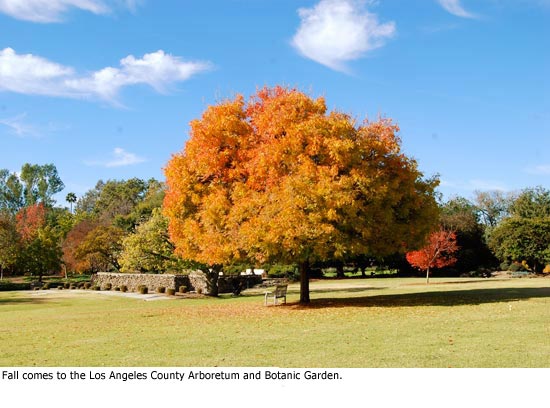An autumn story, in living color
February 13, 2011
Southern California may specialize in the colorful and unexpected, but here’s something that even locals can appreciate as a novelty: From Topanga to Pomona, the hills and streets have turned scarlet and gold with fall foliage. And if the 2010 colors seem unusually vivid, botanists say, it’s not your imagination.
This year’s cooler-than-usual summer and fall, coupled with milder-than-usual Santa Anas, apparently have created the ideal conditions for a New England-style autumn in L.A.
“In the 12 years I’ve been here, this is the best I’ve seen,” said Frank McDonough, botanical information consultant at the Los Angeles County Arboretum and Botanic Garden. “I’m like a surfer on a big wave day.”
Some trees, he said, were changing color for the first time since he’d come to the arboretum.
“Look at that one!” he enthused, strolling with a visitor this week through stands of bright red Chinese Pistache and golden Ginkgo biloba. “Look at that one! Look at that one!”
(For a photo gallery and video tour of the arboretum, see below.)
Deciduous trees in Southern California tend to change colors later and with less visual drama than in cooler climates, but they do exist here, and do change. Poplars brighten the fall in places like Canyon Country and Acton. Crepe myrtles deck backyards in the San Fernando Valley; Liquidambars blaze along boulevards in Westwood and San Marino. Sycamores bring autumn gold to warm inland suburbs and rustic canyons.
But most autumns are too warm and windy for the leaves’ true colors to fully emerge before they dry up and get blown away by the desert winds, says McDonough. Leaves turn because of complex chemical changes triggered as temperatures drop and days shorten. Time plays a big part in the transition.
The bright autumn colors are actually what remain when dwindling sunlight and cooler weather signal the onset of winter, and the green chlorophyll in a leaf starts to dissipate as it stops producing food.
As the leaf’s green-ness ebbs, previously hidden orange and yellow pigments surface. Meanwhile, a red and sometimes blue pigment known as anthocyanin can be generated as cold night air chills the leaf, trapping sugars manufactured in warmer daylight. The result is the emergence of the season’s hallmark golden, copper, crimson and burgundy leaves.
“It’s a process that takes a while and requires cooler temperatures,” says McDonough. “But a lot of times here in Southern California, because we have such hot fall weather, that process doesn’t go very gracefully.”
This year has been different. First, an upper level trough off the coast gave Southern California one of the coldest summers since the National Weather Service began keeping records in the 1940s. Then, after a little September warmth, the soil and air were cooled again by a series of rainstorms.
“October was extremely wet,” notes Jim Ashby, service climatologist at the Western Regional Climate Center in Reno, NV. “Rainfall was 433% of normal at the Los Angeles [International] Airport in Los Angeles, and 254% of normal downtown.”
Then, after a brief heat wave in early November, the mercury again began dropping, with nighttime lows by the end of the month in the low- to mid-40s — coincidentally the perfect temperature for anthocyanin creation.
“It’s definitely been a different weather pattern,” says National Weather Service meteorologist Curt Kaplan.
And what better time to put on your walking shoes and enjoy it than now, in these final days of fall?
A fall day at the Arboretum. Photos by Zev’s Web Staff
Upload your Southern California autumn pictures on Zev’s website by clicking here.
Posted 12/9/10


















 The Rock's significant other
The Rock's significant other





